On Wednesday the Greenwich Dept of Public Works held a third public public information session on drainage. This time it was for residents in the Strickland Brook drainage area.
And like the previous meetings for the Pemberwick and Brothers Brook drainage area, neighbors responded with frustration that the town wasn’t doing more to mitigate flooding. The emphasis was on next steps residents could take to flood proof their own homes.
“What I’m seeing here, is not what the town can do for us, it’s we have to do for ourselves,” said Fred Salkind of Grove Street. “I’m really kind of upset about this. This is a complete waste of time. Who’s got money to wrap a cement wall around their house or even raise their house?”
Before introducing Deputy DPW commissioner Jim Michel, who led the meeting, First Selectman Fred Camillo tempered residents expectations, noting that town’s 100-year old infrastructure was not built to withstand recent flooding.
“There are some areas where I have spoken to people whose homes were built in a little valley 50 or 60 years ago where they shouldn’t have been built,” he said. “They’re getting water all over. They asked, ‘Could you buy us out?’ That would be a great thing to do, or build a little retention pond there, but if you do that once, then everyone is going to ask.”

Camillo said the town had considered building a retention pond in the area of Echo Lane, but that it would have needed to be an area bigger than a reservoir. “That’s how bad the problem is over there,” he said.
Deputy Commissioner of DPW Jim Michel said FEMA would soon be updating their flood maps, and that certain Cos Cob residents might want to get flood insurance even if their properties were not included on the FEMA flood zone maps.
“We’ve been asked before, why doesn’t the town force a change of the maps?” Mr. Michel said. “This gets to be a tricky question for us because if we were to file something with FEMA saying that we feel your map is incorrect and should be updated based upon data we have, that’s going to require all the properties in this zone potentially to get flood insurance, which will be significantly more expensive than now, when you’re not in an officially mapped flood zone.”
“If you’re one of these properties that’s color coded (see below) and you don’t have flood insurance, I highly recommend you have flood insurance, because you are in an area that is prone to flooding,” Mr. Michel said. “Also, we’ve been told it creates a situation that may make it more difficult to sell their property.”
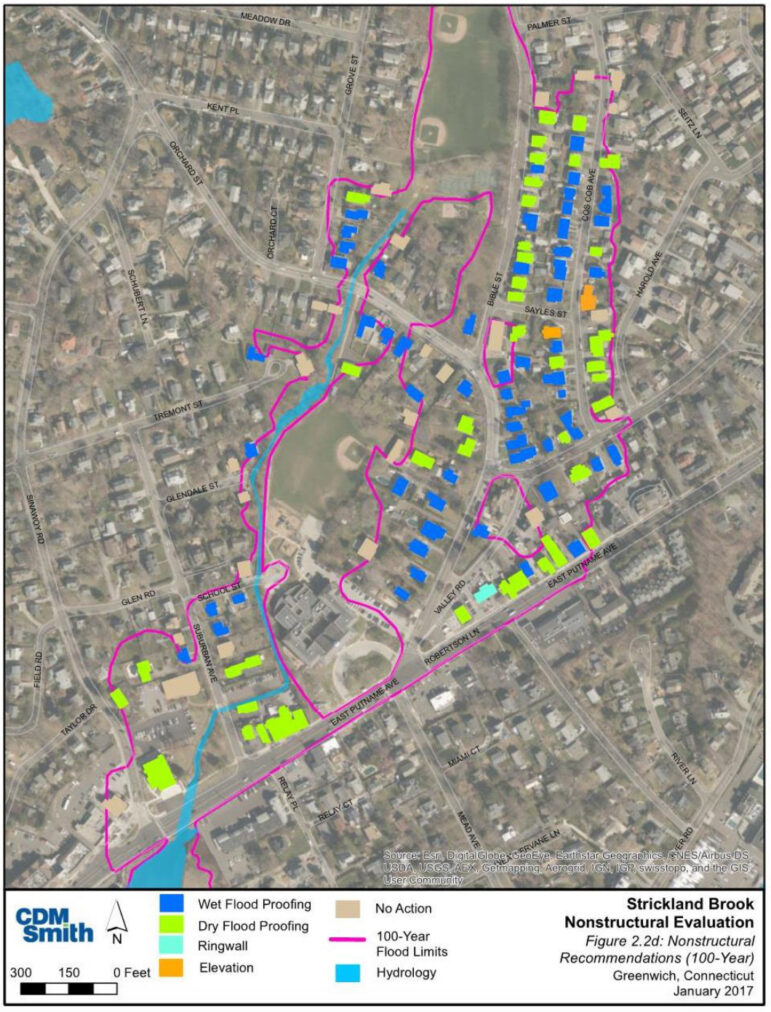
Again, Mr. Michel said DPW had looked at many alternatives and survey information and rainfall data have been collected. “Trying to come up with an acceptable solution to this area has been extremely challenging.”
He said despite extensive studies done by DPW and consultants, possible solutions were not cost effective.
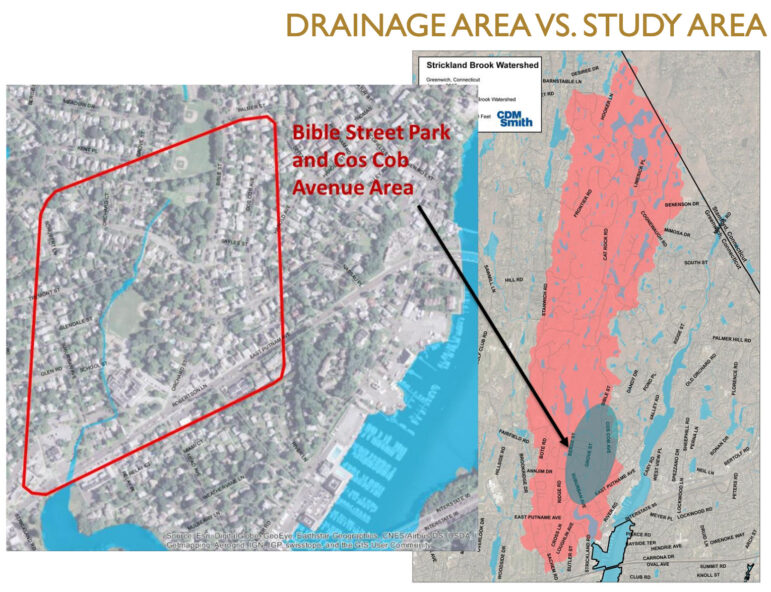
Unfortunately, Cos Cob has issues with both riverine, which is runoff from water flowing downstream, and coastal flooding, which is waster from Long Island Sound pushing up into a drainage area.
The FEMA flood map dates back to dates back to their 1982 study.
But not only have areas changed, but in 1982 Cos Cob was not studied in detail, but rather calculated on the assumption that the flows would be 440 cubic feet per second. But the town’s study found the flow is closer to 950 cubic feet per second flowing into Bible Street Park.
Also, Mr. Michel said the FEMA model did not take into account that the riverine storm flooding in Cos Cob splits off into two, and impacts the entire neighborhood around Bible Street Park.
In a coastal flooding event, once water pools in Bible Street Park, there is nowhere for water to go.
“No offense, honestly this tends to come across as voodoo. I appreciate you as an engineer, and I’m an engineer, and I get it. You can justify a mousing holding an elephant off a cliff.”
– Frank Salkind, Cos Cob
Pumping, Dredging, Water Storage, Diversion Culverts
Mr. Michel said pumping was not a realistic approach with this magnitude of stormwater management.
“A typical fire truck has the capacity to pump water at about 3 or 4 cubic feet per second. That would mean we’d need about 200 fire trucks pumping water during a storm to keep up with this type of flood,” Mr. Michel said.
As for dredging, which has been suggested for Mill Pond, he said it would not benefit the neighborhood to the north.
As for berms, levees or flood walls, Mr. Michel said meeting the Army Corps of Engineers standard requirement of 25 feet clearance beyond the structure would mean taking private property.
As for storage, there was discussion about finding places to store water to be released at a slow rate over a period of time after a storm, including Bible Street Park where there used to be a pond but today is a sports field.
Mr. Michel said that at a public meeting back in 2018 the community had pushed back on the idea of losing the sports field in favor of a retention pond.
Besides, he said, that area is getting to the point where it is impacted by sea level rise and coastal flooding impacts. He said the town had ended review of that idea.
Mr. Michel cautioned against the idea of creating potential pond storage up in the area of Pomerance and Tuchman Parks where there is an existing pond.
“That’s going to take several thousand trees away because we’d have to dig that entire area out,” he said.
As for diverting water through large underground 10 ft wide by 8 ft high “diversion culverts” for a 25-year storm, the town had explored three different locations and all had concerns that during tidal events the pipes would be full of water and not provide the needed capacity. It’s also not feasible given there are many obstacles underground.
The town also considered widening the Strickland Brook channel, but there isn’t a lot of room without taking private property.
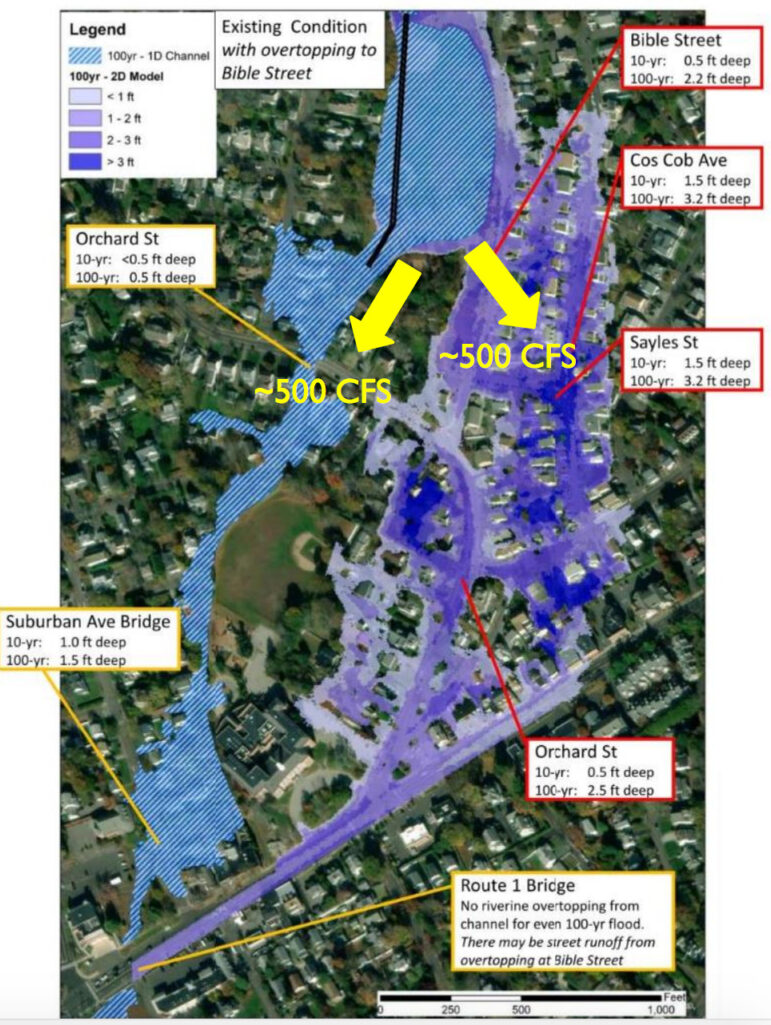
Non Structural Floodproofing
Mr. Michel reviewed non structural approaches residents should consider for their private properties to mitigate flooding.
He shared a map of specific properties recommended for wet flood proofing and dry flood proofing (above) including building ring walls, removable gates for front doors, elevating homes or raising mechanicals to second stories.
He noted FEMA considers anything below a building’s first floor as something to anticipate will be flooded.
Fred Salkind from Grove Street (behind Bible Street Park) expressed frustration.
“I cannot believe the town is not protecting the people who pay taxes and live here. You’re just saying what we have to do. I’m more interested in what you can do,” Mr. Salkind said.
Mr. Salkind said he’d spoken to longtime residents who said Pomerance Park Pond and Mill Pond were both previously 5-6 feet deep.
“No offense, honestly this tends to come across as voodoo,” Salkind said. “I appreciate you as an engineer, and I’m an engineer, and I get it. You can justify a mousing holding an elephant off a cliff.”
“What’s the cost of doing nothing?” asked Adam from Suburban Ave.
Jimmy Santaguida urged the town to consider using the Pomerance property for water storage ponds to help residents in the area.
Ernst Schirmer said he was impressed by the improvements to the newly raised bridge on Sound Beach Ave at Old Greenwich’s Binney Park which were funded by a state grant.
He wondered why similar improvements to flow achieved by that project couldn’t be replicated in Cos Cob.
Jonathan Schmitz who owns property on Suburban Ave, said construction of the bridge on Suburban Ave had unfortunately reduced the hydraulics of the area.
He noted the stream takes a sharp turn around Cos Cob School and the bridge was a barrier.
“The stream has been tortured,” Mr. Schmitz said.
Mr. Schmitz asked Mr. Michel to compare the Suburban Ave bridge to the new Binney Park Bridge.
“That is gigantic, but this (bridge) needs to be changed or taken out,” Schmitz said. “It’s all a matter of mitigation.”
Mr. Michel said the town had analyzed the Suburban Ave bridge.
“It’s one of the things – that it would assist a small stretch, but by the time you get further upstream it doesn’t have any impact,” Mr. Michel said.
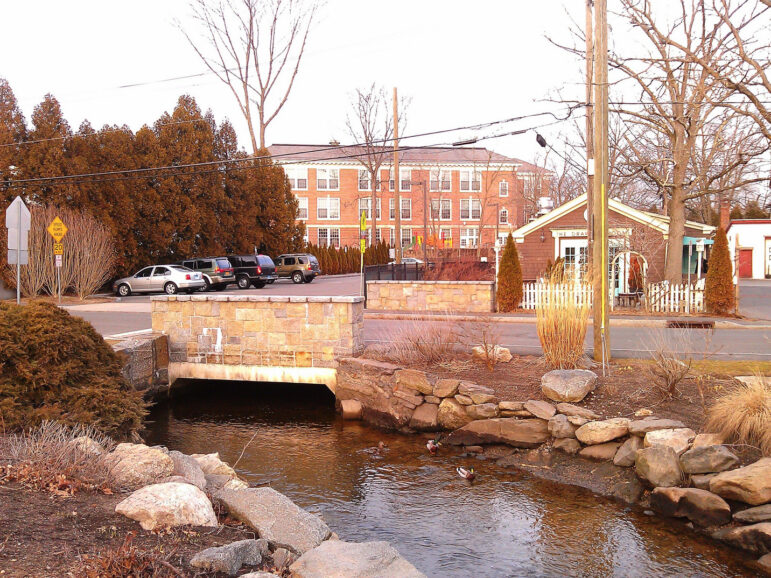
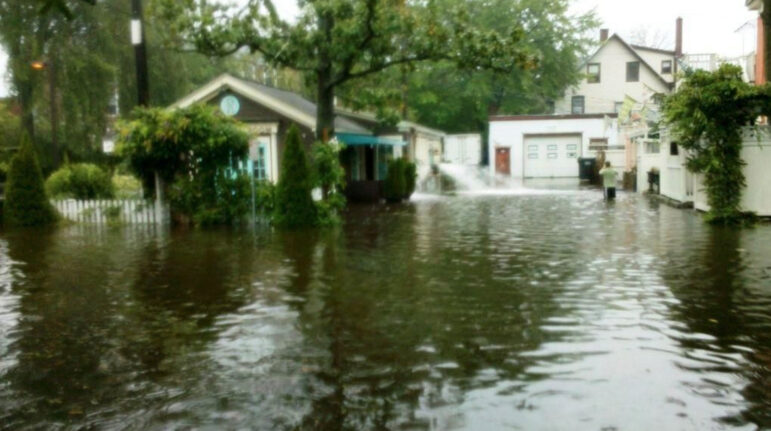
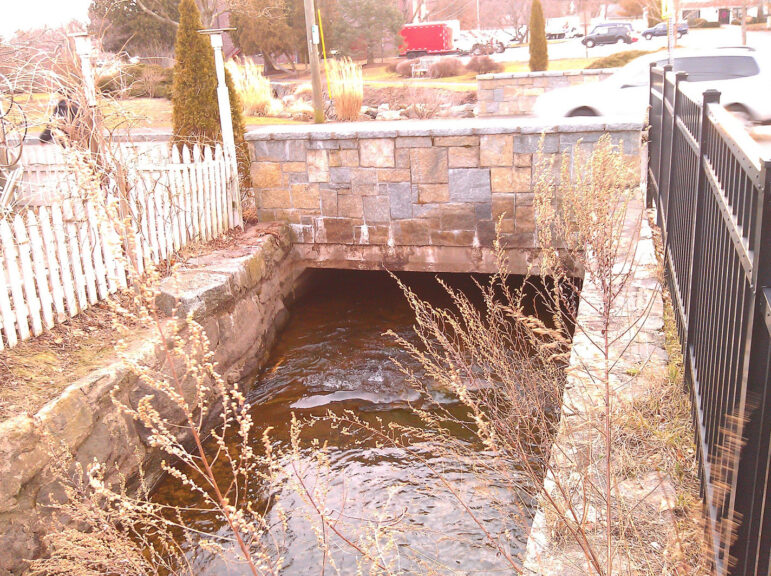
Arn Welles suggested diverting water from the area of Mianus Park to move water into the Mianus River. He also suggested dredging Cos Cob Pond and adding flood gates so the pond could be emptied prior to a storm to create storage capacity.
“The sheer volume of water we have coming in is significant. Environmentally that would be a very challenging improvement to do,” Mr. Michel said.
“So let’s do it, if it’s challenging!” someone shouted.
Mr. Schirmer urged action. “We cannot delay until the next generation. Let’s just talk about the money. DPW, you do amazing things, but the last two years, how much money did you actually invest in improvements in storm water management and how much do you have for the next year?” he asked.
“We have invested a decent amount of money in storm water management,” Mr. Michel replied.
“In dollars please?” Schirmer asked.
“It varies from year to year,” Mr.Michel replied. “We probably have about $4 million in ARPA funds for storm water projects. Each year we have about $750,000 we put in for maintaining infrastructure. I’d have to take a look at the budget.”
Peter Quigley said CDM had done a thorough study for the town in 2011-2012 and suggested a plan to put in a storm drainage system to manage storm water with a price tag of $300 million.
“Storm drains are separate than your sewer system. They run parallel. If you don’t have storm drains, guess what happens to the sewer system? It overflows and takes the water,” Quigley said.
Mr. Michel said some of the recommendations in that study were on private property and many were recommendations for surface drainage – keeping water off of the street.
“It’s called funding!” Quigley said emphatically, adding that if the town had set aside the same amount of money it does for sewer maintenance – $15 to $20 million annually – the town would be in a much better position.
Mr. Michel said his department puts in budget requests every year to fund these type of projects.
“We understand there is only so much funding to go around,” he said.
Adam Nalewajek from Suburban Ave, whose property is in the vortex of both riverine and coastal flooding, said there were numerous interests at play. He warned that if nothing was done he was concerned about emergency service access to Cos Cob School.
“What’s the long term impact of doing nothing despite having a really big problem?” Nalewajek asked.
Mr. Michel said DPW had studied the impact to Bible Street should it become impossible to get emergency vehicles through that area.
“We have struggled and have not come up with a solution,” he said. “There really isn’t a good methodology we’re aware of.”
“We should look at this in a unified way,” Nalewajek said. “Ultimately the funding would exist somewhere. I would never want to tell anybody to mandate flood insurance or change flood maps, but ultimately enough voices will rise to the level required, and I think Cos Cob is important to warrant that.”
Myra Klockenbrink said the state legislature had discussed adopting the concept of a storm water authority piloted successfully in New London, where there is a fee imposed, much like a utility, based on the amount of impervious surface on a property.
She said New London had raised enough through the program to substantially meet its infrastructure, maintenance and capital costs for drainage.
Chris von Keyserling said, “It seems to me that if the town can’t create flood control, which is one of its responsibilities over the years, there should be some way of subsidizing the homeowner for upgrades because this is an area problem, not an individual problem.”
“If you keep it out of my basement, it’s got to go somewhere else,” he said.
Click here for the May 10 Strickland Brook public meeting presentation.
See also:
DPW drainage meeting addresses challenges for residents “at the bottom of the bathtub” Jan 22, 2023
PHOTOS, VIDEO: Friday Flooding in Cos Cob Was Precursor to Severe Cold and Wind Dec 23, 2022
Pemberwick Residents Advised by DPW to Share Responsibility for Flood Risk Reduction Nov 15, 2022
Pemberwick Cleans Up Post-Ida Flooding: “Now We’re a Retention Pond” Sept 5, 2021